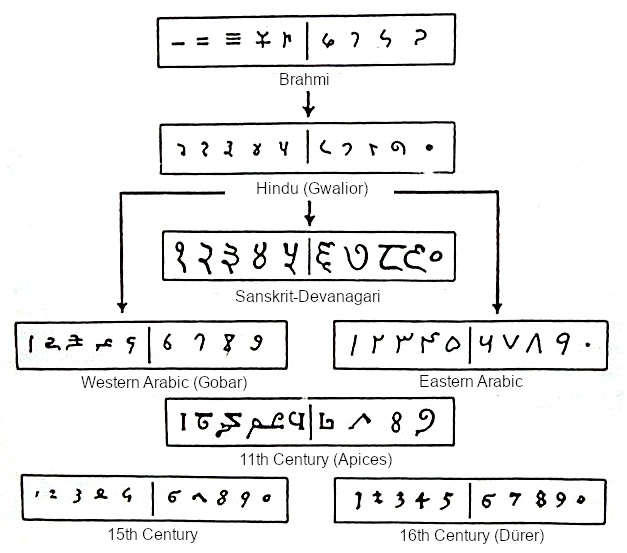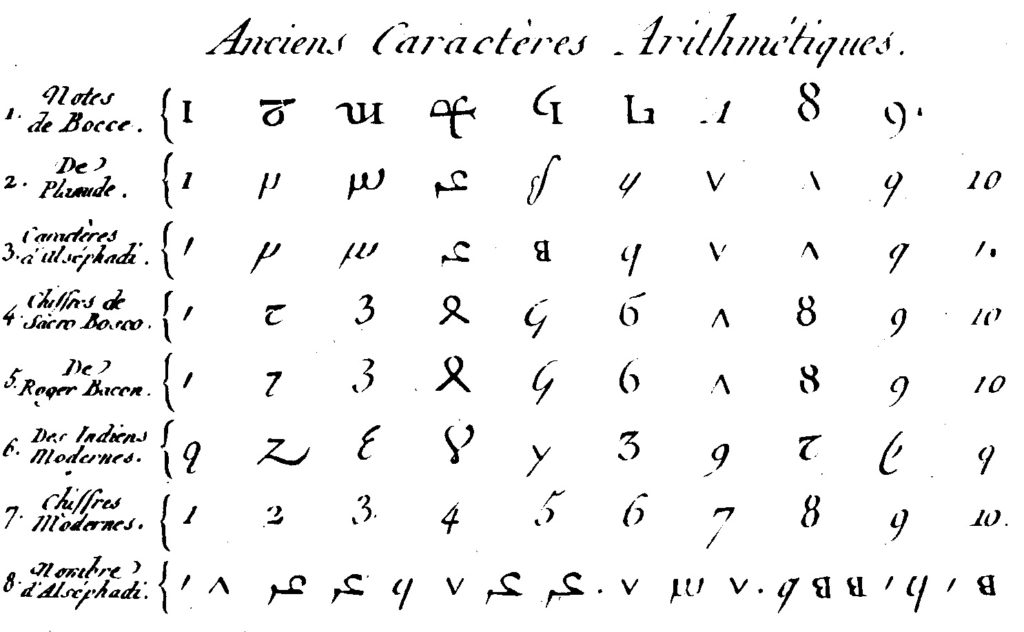
Where did Arabic numerals come from? They evolved from a writing system created in India in the 3rd century BC.
The first evidence of prehistoric humans using numbers comes from a bone dated from 43,000 years ago. It is the Lebombo bone and it is a baboon femur with 29 notches carved into it. It is broken at one end, so could conceivably have had more notches. It is thought to be the first example of counting in the world. People probably started by counting on their fingers but may have realized that they needed to keep a record of whatever they were counting. Simple notches is the easiest way. However, the problem with a notch based counting system is that you have to have more and more notches if you are counting a lot of things.
People didn’t really need to count until they settled down in communities. You don’t really need numbers until you have a system of mine and yours. When that exists, you need to have a tally of who has what. The first real counting system was created by the Sumerians in about 4000 BC. They used tokens to represent things. If someone had 5 chickens, they were given 5 tokens. Soon, they did away with the tokens and just made marks on clay tablets. In order to be able to trust the marks on the tablets, they created official accountants who would stamp the tablet to authorize the count.
The Egyptians improved upon that system. They took the marks used to count things and used them to apply to different things that hadn’t been counted before. It was suddenly possible to measure because you could have 1 cubit. They also started to use symbols instead of marks because you can’t make a hundred or a thousand marks. The Greeks used a similar system that had symbols instead of marks. They used the letters in their alphabet. The first nine letters were 1 to 9, and then the next 9 letters were 10 to 100. Some of these were taken up by the Etruscans and some were dropped. The Etruscan system was taken up by the Romans and slowly evolved into the Roman numerals that we know. This system was taken all over the Roman empire and actually survived into at least the 15th century throughout Europe. The fact that most of us can still read Roman numerals means they still survive, but we don’t usually use them.
So, where did Arabic numerals come from? It was a system that evolved in India between the 1st and 4th centuries. There was a counting system in India from about 1200 BC. Similar to most of the other counting systems that evolved, it was not very easy to write large numbers. The more symbols in a numerical system there are, the harder long numbers are to transpose. Many of the earlier systems were not positional. A positional system means that the number in that position has a certain value. For example, the 8 in 834 is in the position of the hundreds and so means 800. The I in IX doesn’t occupy a specific position and doesn’t have a value because of its position. Positional systems are much easier to write, but they are difficult to do without a zero. The zero was invented at least 2700 years ago, but it wasn’t used as an actual number in the positional system until the 5th century AD in India.
The symbols that became Arabic numerals started as Brahmi numerals in about 300 BC. Some of these symbols look similar to our modern numbers. No one knows where the Brahmi system of numbers came from. They could have been letter based like the Greek system. They certainly weren’t positional. These numbers evolved into the Gupta numerals around the 4th century AD. (When I say evolved, they also evolved into lots of other types of numerals that don’t look like modern numbers.) The Gupta period was from the early 4th century AD. The Gupta numerals were spread over large parts of northern India. Sometime during the Gupta period, people started to use the numerals with a positional system. The Gupta numerals evolved into the Devanagari numerals in about the 7th century and they look more like the numerals we use today.
These Indian numerals were carried to the growing Arabic world in the 7th century AD. However, as with India, there were several numeral systems in operation at the same time. The numbers that will become our Arabic numbers were one of those systems and they evolve further over the next few hundred years. One big change is that they are all rotated by 90 degrees because the Arab scholars wrote on scrolls that had to be turned to be read. This changed the original 2 and 3 into the 2 and 3 that we recognize.

The numerals that are now being used in the Arab world travel to Europe. The first sign of them being in Europe is in 976. They start to spread as more European mathematicians study Arabic math. The Arabic numbers are easy to learn, very easy to use, and great for mathematics. They really take off when Leonardo Fibonacci used them and promoted them in one of his books. His books on mathematics were used for hundreds of years. However, it is the invention of the printing press that really seals their place. Most scientific books that were printed used this new system of simple Arabic numerals. They were printed and made official. Just like the printing press standardized spelling, it standardized numbers. The printing press helped spread the new numbers across Europe. Between 1396 and the end of the 15th century, they are popping up throughout England. By the middle of the 16th century, they have pretty much replaced Roman numerals. And this is what I learned today.
Source:
https://en.wikipedia.org/wiki/Greek_numerals
https://wonderopolis.org/wonder/who-invented-numbers
https://en.wikipedia.org/wiki/Lebombo_bone
https://en.wikipedia.org/wiki/Etruscan_numerals
https://en.wikipedia.org/wiki/History_of_ancient_numeral_systems
https://www.nature.com/articles/459646a
https://mathshistory.st-andrews.ac.uk/HistTopics/Arabic_numerals/
https://mathshistory.st-andrews.ac.uk/HistTopics/Indian_numerals/
https://en.wikipedia.org/wiki/Hindu%E2%80%93Arabic_numeral_system
